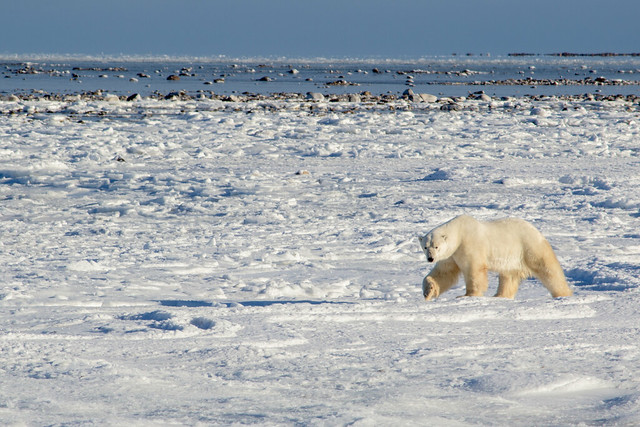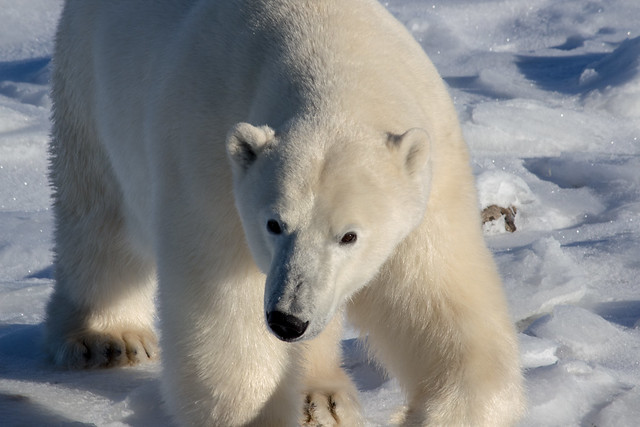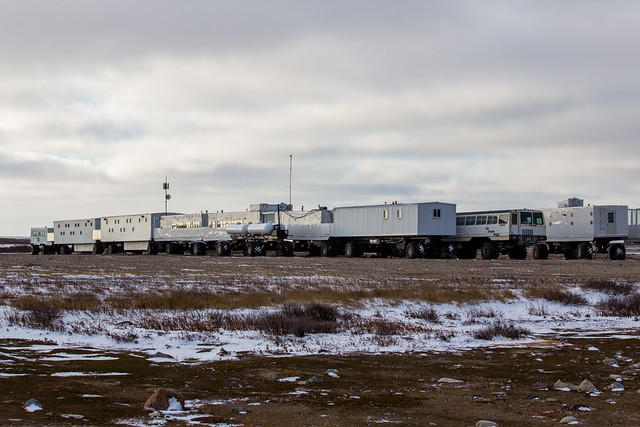It’s a cold and blustery day here in Copenhagen. Snow has been falling all day – the cold air converting biker’s deep breaths into jets of steam. The barely audible grunts as they strain against their pedals, pushing their bikes up to speed through the slush, toys with my memory. The combination of sights, sounds and cold sensations triggers a tingle along my spine and memories of Churchill, Canada.
I knelt in the icy cold on a welcome mat, set up over a metal grate-turned rear deck on one of the cars that makes up the Tundra Buggy Lodge. Below me the hulking snow-white head, black nose, and purple tongue of a polar bear perched delicately on the trailer hitch. Her face pressed up against the grate, less than two inches from my own. The heat of her warm breath sending forth similar jets of steam as she grunted, sniffing, drawing in my scent, eyeing me and then chewing on the wooden support strut. I scolded her gently, at least as much as a small, fragile, human like myself can scold a hulking 1,200 pound creature.
Over the three days I spent out on the frozen tundra with the bears I learned a lot about them. The world’s obsession with polar bears is a tribute to their beauty and exotic charm, but beyond that they are deeply intelligent creatures that harbor a mixed sense of playful curiosity and comical quirkiness which comes from being at the top of the food chain and living in an area where the only threat is starvation, other polar bears, and on a very, very rare occasion humans. It’s easy to think of them as giant dogs or cats. Playful, sociable, slow-moving, and infinitely lazy. It’s only when you get the chance to see them “play” or when you come nose-to-nose with them that you realize how fast and deadly they truly are. These giants of the ice usually live into their 20s though the oldest on record died at the age of 42 in a zoo. They are crafty, full of personality, and can be extremely social.
I was lucky. My introduction to the bears stretched over three days and two nights during which we slept, ate, drank and watched the bears. It was an odd experience – once we stepped on to the rear viewing deck of the custom-built Tundra Buggy we committed ourselves to three days floating 10 feet above the frozen tundra and lakes of Wapusk National Park. We spent our days on the Buggies – what felt like super-sized school buses on 5 foot tall wheels – and our nights docking with the Tundra Buggy Lodge. The lodge itself is little more than a series of custom tundra buggies attached end to end like a giant land train. It’s a fascinating piece of innovation. The two sleeper cars have running water, flush toilets, comfortable bunk beds with privacy curtains and custom thermostats for each bunk. Meanwhile each also has a window allowing for an intimate view of the wild tundra. When I first heard about the lodge, I thought it would be a fixed building. When I learned it was deep inside the national park and mobile, I was slightly confused. When I first saw it, I expected it to be rough and rugged. Once we boarded it and reached our bunks, I found myself shocked and impressed. The seemingly daunting prospect of spending three days without touching the ground was quickly disappearing. The only thing that was missing? Wifi. Which, in retrospect, I’m glad was absent. It kept us more social and the experience more authentic, engaged, and detached from society and the world at large.
The bears are drawn to the point an hour and a half outside of Churchill by mother nature. Recharged and relaxed after a warm summer spent to the south, they migrate en masse to the area to wait, not unlike a restless boarding party waiting for their ferry, for the ice to begin to freeze and the Hudson Bay to transform from restless waves into a frozen desert. The point rests horizontally when viewed on maps. A dam of sorts that slows down the counter-clockwise rotation of the bay’s currents. At the same time nearby rivers dump fresh water into the bay, water which floats atop the currents, gathers against the dam, and then freezes before the rest of the Hudson Bay’s salty frozen waves. Somehow the bears figured this out generations ago and now they gather, waiting eagerly, to be the first ones out onto the ice. Anticipating the opportunity to hunt seal and whale alike, feasting and preparing for the depths of winter and hibernation.
As I prepared for the trip I told myself I’d be happy if I saw one polar bear. If I got lucky, I figured I’d see two and they might be active. As it turned out, our timing was fantastic and in addition to clear blue skies and cold weather there were a lot of bears. Our position at the lodge was also smack dab in the middle of their congregating spot which meant zero commute time and provided us with the opportunity to watch the bears under the setting moon and during sunrise. The end result? Bears. Lots and lots of bears. While it’s impossible to guess which bears we saw multiple times, I’d put the number at more than 10 and possibly closer to 15 over the course of our stay. We also had the opportunity to see several beautiful birds, a red fox, and a white arctic fox. The bears were typically active early in the morning and again late in the afternoon just before sunset.
To say that the bears were active is, perhaps, a bit of an understatement. One of the great highlights of the trip came after four bears had ambled into the area, become acquainted, and paired up. Then, they began to play. But, these bears didn’t play like you and I might. They play fought, which often drew blood and resulted in flying snow mixed in with long trails of spittle. Acquainted, the bears would collide with each other, battling for a minute or so, and then wander off to cool down briefly before throwing themselves at each other once again. Eventually two squared off about 25 feet away from our vehicle, while another two started to circle 300 feet or so in the distance. Then, almost as if on cue, the two sets took to their hind legs and began to circle simultaneously – a bit like two boxers sizing each other up – they would take a few swings, collide against each other, and then battle with teeth, legs, paws and claws. It was incredible. Where I’d only hoped to see one polar bear lounging in the kelp, I found myself watching four engaged in mock combat, all framed by frozen kelp, fresh snow, and the gray blues of the Hudson Bay in the background.
The previous morning had started before sunrise. When it’s close to -10 Celsius outside and there is a bitter cold wind to go with it, getting up isn’t easy. Luckily, we managed, scarfed down our food, and were in the truck as the moon started to speed up its descent towards the horizon. We had been lucky to arrive during a massive full moon. Its pale white light lit up the early morning tundra and was powerful enough that if not for the bears, it would have been possible to walk the tundra at night without a flashlight. Once we boarded the Tundra Buggy and started to move, we paused almost immediately – perhaps 25 feet from the lodge. There, not too far from camp, was a lazing polar bear finishing her evening nap. Our driver artfully lined us up and I watched in awe. What transpired was one of the most powerful and captivating moments I’ve ever experienced. It was THE “National Geographic Moment” of the trip and one of the most spectacular things I’ve seen to date. The full moon slowly slid down towards the horizon…closer-and-closer to the thin line of hazy clouds that floated just above the Hudson Bay’s choppy waves.
At the same time the first reds and orange hues of sunrise started to settle over the tundra. They turned the full moon a brilliant pinkish-red and gave it the look of the setting sun. Then, the moon began to merge with the horizon, its deep red cut by the clouds and reflected by the ocean. It was at that moment, as the moon slowly sank below the horizon, that the polar bear lifted its head, and looked at us. I snapped one more photo and then paused, staring back at the bear, taking in the moment. I was completely ensnared in the magic of it. Awestruck by the purity of the moment and its rare beauty. Then it was gone. The final blood-red lip of the moon slipped below the horizon, the bear returned to its nap, and the bright reds of pre-dawn began to light the sky, slowly growing in intensity until the sun finally burst through the clouds and began to climb its way northward.
The great thing about Wapusk National Park and being out at the Tundra Buggy Lodge was that even without the bears it was stunning. You’re out in the midst of a national park in the heart of Canada’s rugged and rural interior. There is always wildlife in the form of small birds and ground game and the light is incredible. The sunrises are gorgeous. The view of the moonlit tundra late at night, the vivid colors reflecting off snow, ice, and water during sunrise, all combine to create a magical dream-like place. Other small details that really stuck with me were the wonderful patterns frozen into the ice where the wind blew as the water froze. The only tiny disappointment was the lack of northern lights but the brilliant moments under a full moon and our incredible luck with the bears more than made up for it.
You can see my complete polar bear album here which includes 152 shots of bears playing, relaxing, and fighting. It was shot on a Canon T3i (600D). You can also see footage of polar bears playing, relaxing, and wandering over on my youtube channel.
This is Part III in my three part series about my trip to Churchill, Manitoba. You can find information about the cost, and logistics in Part I as well as info about Churchill. Also, in Part II you can read about my introduction to Dog Sledding.


